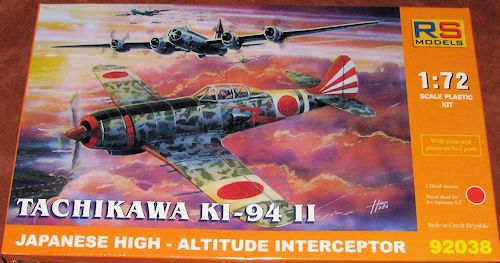
RS Models 1/72 Tachikawa Ki-94-II
| KIT #: | RS 92038 |
| PRICE: | $35.98 SRP |
| DECALS: | Two whiffer options |
| REVIEWER: | Scott Van Aken |
| NOTES: | Short run kit |

| HISTORY |
The first was a twin-boom monoplane with two 1,641 kW (2,200 hp) Mitsubishi Ha-211 18 cylinder engines, driving two 4-blade propellors in a push-pull configuration. The very heavy armament that should have been mounted on the aircraft (two 37 mm/1.46 in and two 30 mm/1.18 in cannons, should have been enough to make short work of most US heavy bombers of the era. Notwithstanding the outstanding prospective performance, which however was judged as "unduly optimistic" by the technical department of the Japanese Army Air Force, this design was judged too complex by the technical department and the design was discarded.
The second Ki-94 design, made by a team under Tatsuo Hasegawa, chief designer of the aircraft and responsible for the used airfoil, was a more conventional single-seat, piston-engine monoplane fighter, developed for the Imperial Japanese Army Air Force along the same requirements as the Nakajima Ki-87, which had been the Army's fall-back design for the original Ki-94. Intended to counter B-29 raids, it was optimized for high-altitude interception with a pressurized cockpit and heavy armament.
This design was approved by the Koku Hombu, and the aircraft was designated Ki-94-II (the scrapped earlier Ki-94 design was named the Ki-94-I). An order was placed for one static test airframe, three prototypes, and eighteen pre-production aircraft. Only 2 prototypes were built in the event; the first was equipped with a single Nakajima Ha-44 engine, driving a 4-blade propeller because the 6-blade one was not ready. The second prototype was to be fitted with a 6-blade propeller. The war's end however stopped the construction of the second prototype and also found the first prototype still being readied for its maiden flight; the Ki-94-II never taking to the air.
| THE KIT |
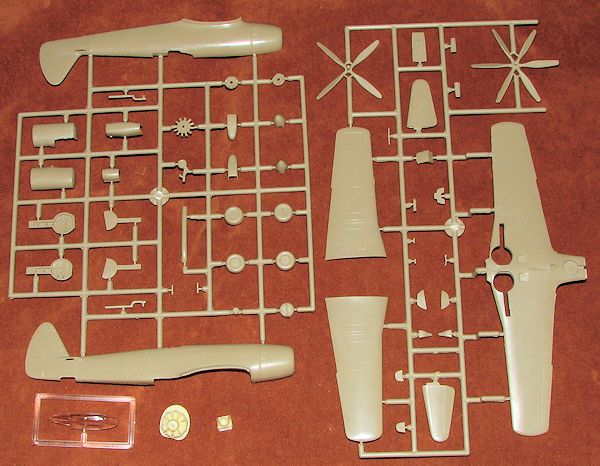 This one
comes in a box that is larger than the usual from RS Models. Still an
end-opening type and once open it is obvious that the kit is smaller than the
size of the box. The two tan sprues must have been too long for the standard box
so the next size up was used.
This one
comes in a box that is larger than the usual from RS Models. Still an
end-opening type and once open it is obvious that the kit is smaller than the
size of the box. The two tan sprues must have been too long for the standard box
so the next size up was used.
As is normal for RS kits, this one has superbly done exterior engraving that is quite fine compared to some other kits, and crisply molded as well. This one come with a pair of resin parts. One is the aft end of the optional oil cooler and the other is a nicely done engine. My engine had a cylinder broken off and it was not in the bag with the other part so it must have happened taking it out of the mold. Not a problem as the aircraft has a large cooling fan that will block most of the engine from view.
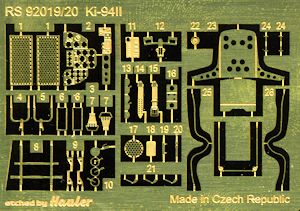 Photo etch
is used for most of the cockpit, as you might guess. This includes the seat,
seat framework, rudder pedals, instrument panel, various items that attach to
the floor and sidewalls (some of which are several layers).
P.e. is also used for intake screens for the turbocharger system. In fact, this
aircraft has quite a few of these rather large intakes on the fuselage sides and
under the wings.
Photo etch
is used for most of the cockpit, as you might guess. This includes the seat,
seat framework, rudder pedals, instrument panel, various items that attach to
the floor and sidewalls (some of which are several layers).
P.e. is also used for intake screens for the turbocharger system. In fact, this
aircraft has quite a few of these rather large intakes on the fuselage sides and
under the wings.
There are separate wheel wells that fit into the
lower wings and the kit has two piece main wheels. A single-piece canopy fits
atop the fuselage. The modeler has the option to building the aircraft in either
the pr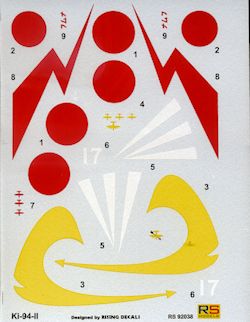 ototype
or projected production version. The differences are in the prop, with the
production variant having a six blade version, and in the lower oil cooler
intake. The production version is considerably longer. The builder will have to
scratch build a radio mast. You will also need to drill holes in the leading
edge of the wing for the gun barrels and pitot tube.
ototype
or projected production version. The differences are in the prop, with the
production variant having a six blade version, and in the lower oil cooler
intake. The production version is considerably longer. The builder will have to
scratch build a radio mast. You will also need to drill holes in the leading
edge of the wing for the gun barrels and pitot tube.
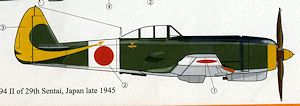 Instructions
are well done with generic color information provided during the build process.
Markings are provided for two whiffer schemes. One is the box art plane from the
18th Sentai in bare metal with heavy mottling and the other is from the 29th
Sentail in dark green upper and bare metal undersides. Both have wing leading
edge ID bands. The decal sheet is very nicely done and while the modeler will
need to match the decals for the colors on the nose, it should not be an issue.
Instructions
are well done with generic color information provided during the build process.
Markings are provided for two whiffer schemes. One is the box art plane from the
18th Sentai in bare metal with heavy mottling and the other is from the 29th
Sentail in dark green upper and bare metal undersides. Both have wing leading
edge ID bands. The decal sheet is very nicely done and while the modeler will
need to match the decals for the colors on the nose, it should not be an issue.
| CONCLUSIONS |
Like their other prototype kits, this one is done in three boxings with two of them offering whiffer markings. To do the real plane, I would guess that only the insignia would be required. Not sure if it would have been painted prior to its first flight so that would be up to the builder. It is actually a very large aircraft for a single seat fighter, and however it is done, will look very nice on your display shelf.
| REFERENCES |
Review kit courtesy of your editor
If you would like your product reviewed fairly and fairly quickly, please contact the editor or see other details in the Note to Contributors.